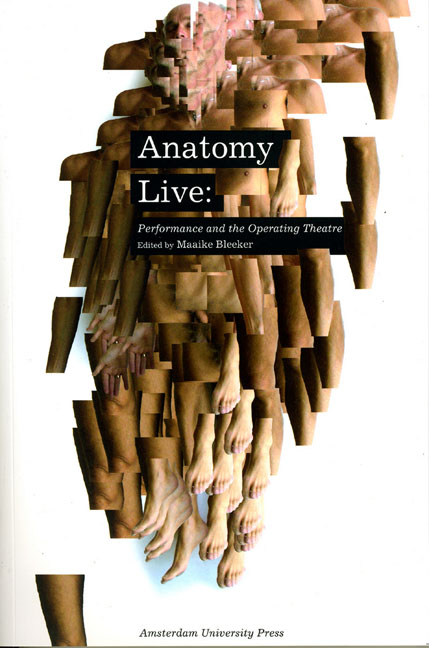Book contents
- Frontmatter
- Contents
- Acknowledgements
- Prologue - Men with Glass Bodies
- Introduction
- Performance Documentation 1: Holoman; Digital Cadaver
- Digital Cadavers and Virtual Dissection
- ‘Who Were You?’: The Visible and the Visceral
- Performance Documentation 2: Excavations: Fresh but Rotten
- The Anatomy Lesson of Professor Moxham
- ‘Be not Faithless But Believing’: Illusion and Doubt in the Anatomy Theatre
- Performance Documentation 3: De Anatomische Les
- Of Dissection and Technologies of Culture in Actor Training Programs – an Example from 1960s West Germany
- Ocular Anatomy, Chiasm, and Theatre Architecture as a Material Phenomenology in Early Modern Europe
- Performance Documentation 4: Camillo – Memo 4.0: The Cabinet of Memories – A Tear Donnor Session
- Martin, Massumi, and the Matrix
- Performance Documentation 5: Sensing Presence no 1: Performing a Hyperlink System
- ‘Where Are You Now?’: Locating the Body in Contemporary Performance
- Performance Documentation 6: Under My Skin
- Anatomies of Live Art
- Performance Documentation 7: Crash
- Restaging the Monstrous
- Delirium of the Flesh: ‘All the Dead Voices’ in the Space of the Now
- Performance Documentation 8: Körper
- Operating Theatres: Body-bits and a Post-apartheid Aesthetics
- Index
Performance Documentation 8: Körper
Published online by Cambridge University Press: 10 February 2021
- Frontmatter
- Contents
- Acknowledgements
- Prologue - Men with Glass Bodies
- Introduction
- Performance Documentation 1: Holoman; Digital Cadaver
- Digital Cadavers and Virtual Dissection
- ‘Who Were You?’: The Visible and the Visceral
- Performance Documentation 2: Excavations: Fresh but Rotten
- The Anatomy Lesson of Professor Moxham
- ‘Be not Faithless But Believing’: Illusion and Doubt in the Anatomy Theatre
- Performance Documentation 3: De Anatomische Les
- Of Dissection and Technologies of Culture in Actor Training Programs – an Example from 1960s West Germany
- Ocular Anatomy, Chiasm, and Theatre Architecture as a Material Phenomenology in Early Modern Europe
- Performance Documentation 4: Camillo – Memo 4.0: The Cabinet of Memories – A Tear Donnor Session
- Martin, Massumi, and the Matrix
- Performance Documentation 5: Sensing Presence no 1: Performing a Hyperlink System
- ‘Where Are You Now?’: Locating the Body in Contemporary Performance
- Performance Documentation 6: Under My Skin
- Anatomies of Live Art
- Performance Documentation 7: Crash
- Restaging the Monstrous
- Delirium of the Flesh: ‘All the Dead Voices’ in the Space of the Now
- Performance Documentation 8: Körper
- Operating Theatres: Body-bits and a Post-apartheid Aesthetics
- Index
Summary
The fact that Sasha Waltz decided to inaugurate her position as co-director of the Berlin Schaübuhne am Lehniner Platz with a piece called Körper is no minor issue. The Schaübuhne is considered the ‘Holy Grail of dramatic arts’ and ‘the most fiercely intellectual of German theatres’ (Bowen, 2000) and has during the past thirty years promoted some of the greatest names of German text-based theatre. The unprecedented move to not only ‘include’ but to give a position of such privilege as the artistic direction of the company to a choreographer allows ‘the body’ to take centre stage.
Sasha Waltz 's appointment might be called a sign of the times, now that the body has taken centre stage in much theoretical research as well, and has become an accepted component of discourse for scholars in a variety of subjects. In this cultural context, Sasha Waltz is called upon by the Berlin Schaubuhne to take the place of the anatomist in the historical anatomy theatre and show us the body. Waltz's works acknowledge that such showing is not without complications.
Visibility promises knowledge about that which previously remained unintelligible, obscure or hidden. This is the promise also presented by the anatomical theatre : namely, that ocular experience corresponds directly to knowledge about the human body and maybe even about the mysteries of the human soul. To see is to know. However, as Joan Scott observes, visibility may actually function to obscure rather than to enlighten. Reflecting on the desire to ‘render historical what has hitherto been hidden’ by ‘document[ing] the lives of those omitted or overlooked in accounts of the past,’ Scott warns against the danger implicit in this ‘making visible’, pointing out that ‘it may reproduce rather than contest given ideological systems (…)’ (Scott, 1991, p. 775, 778). This, in her view, occurs because when making something or somebody visible one tends to take for granted that which one is making visible, and thus neglects to enquire upon its constructedness.
- Type
- Chapter
- Information
- Anatomy LivePerformance and the Operating Theatre, pp. 245 - 250Publisher: Amsterdam University PressPrint publication year: 2008



